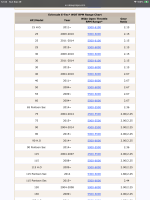ok...so, I think rubex is correct. Jimmbo is correct. You have to test the boat in one configuration.
And I'm sorry, I ass-u-me(d) ...you knew more, so I'll back up some.
Your motor operating manufacturers rpm range is 5500-6000 @ WOT.
Standard opinions on ventilation plate starting position is even with hull bottom, but yeah , can be maybe higher or lower.
Regardless, pick your testing position.
Rule of thumbs: this is with everything else being equal...@WOT....and +/-...
every 1" of prop pitch, up or down, gives a 200 rpm change , down or up.
17" - 18" slows rpm by 200 rpm.
Increasing diameter by 1" slows rpm by about 200, opposite is reverse.
Increasing by one blade ( 3blade to 4blade) decreases rpm by about 200
opposite is reverse.
Raising a motor can increase ventilation issues especially in turns, increase rpm, increase speed.
Lowering a motor can eliminate ventilation issues, lower rpm's but enable more "bite", but increases drag thereby reducing speed.
Adding weight to a boat decreases rpm, decreases speed. opposite is true.
Even different manufacturer props that are close to the same size can give different results because of blade shape or cupping...
...so...
It depends on what you want.
I propped my pontoon for pulling (torque) under load, not speed.
Also, for example, the Merc 4-14x14..Merc 3-16x13 and Solas 3-15.5x13 ALL gave the same results for my boat. Props are not magical. They are for fine tuning.
Now you see why we ask all these questions. There are many variables to consider.
pick a starting point with your boat, don't change anything, and correct #'s, then give us the max rpm @WOT so we can give options correctly.
If my minimum rpm @WOT is 5500, I would not operate my boat @WOT below that rpm. So when fully, legally loaded, I want to be above that.
That's just me.




















